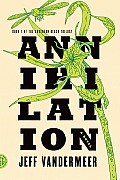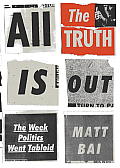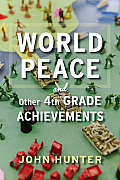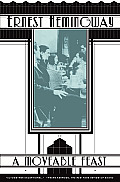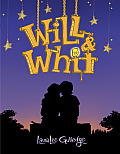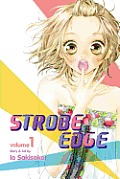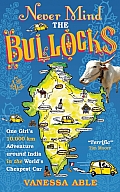Link to this review in the form of a comic strip by geneambaum tagged science fiction

Click for the full-sized comic
@bookblurb Four scientists investigate a mysterious area slowly being reclaimed by nature, where things are not what they seem.
Link to this review by flemtastic tagged nonfiction
Gary Hart was a different kind of politician. He was intelligent, had a firm grasp of policy, and spoke easily, but he had little patience for the media and the hoops Presidential contenders had to jump through. He came out and told reporters he would not be participating in discussions about poll numbers or in photo shoots. His adversarial relationship with the press came back to haunt him later. When he was leading all Democratic primary polls for 1988 by a wide margin, there were allegations of marital trouble and womanizing. Hart, looking to put the rumors to rest, briefly discussed his personal life. Then two reporters from the Miami Herald followed him and saw Donna Rice stay overnight at his residence. After an anguished meeting where they wondered whether or not to publish these details about a Presidential candidate’s personal life, the Herald went ahead with the story and all hell broke loose.
Originally hoping he could survive the scandal, Hart tried to stay in the race, but the news was everywhere, and soon Hart was drummed out. In later years, Hart tried to cast himself as an elder statesman, but with mixed results; though he had the skills to offer, Hart always brought a hint of scandal with him. Through extensive interviews with a very cooperative Hart, Bai gets the real story of Hart’s whole political life, including his most open comments to date about the scandal.
Why I picked it up: Gary Hart was running for President when I was about to turn eighteen. He would have had my vote if he had avoided this scandal and stayed in the race.
Why I finished it: I learned that everything I thought I knew about the Gary Hart / Donna Rice scandal was wrong. I believed that Hart had challenged reporters to follow him, and that when they did, they took a damaging photo and published it. In fact, the reporters that followed him had not heard Hart’s infamous challenge inviting reporters to follow him because they wouldn’t find anything. The damning photo that chased him out of the race was not published until weeks after he had already withdrawn from the race.
Johnny Carson was one of the first harbingers that the scandal was not going to blow over. He tore up his monologue the night after the scandal broke; he said he was just going to read the newspaper headlines about Hart because they were just as funny. He then talked about Hart for the entire routine.
It’s perfect for: My friend, Neal, a political junkie. He would enjoy all the details about Hart’s ascension in the Democratic Party and his reminiscences about his political career. At an especially poignant part, Hart quotes The Parable of the Talents. He tearfully admitted that he believes in eternal judgment where he will be called to justify his life: “I will be judged by how I did or did not use the talents I was given. And I don’t think I’ve used them very well.”
@bookblurb The truth about the Gary Hart / Donna Rice scandal that erupted during the 1988 Presidential race.
Link to this review by darcy tagged coming of age
Brendan seems to have it all. He’s got a spot on the wrestling team and a cute girlfriend. The problem is he’s not happy and doesn’t feel comfortable in his skin. He fantasizes about being a girl, but doesn’t want to be labelled a freak.
Why I picked it up: I’m drawn to novels in verse, and I was intrigued a book about transgender teens because there aren’t many on the market yet.
Why I finished it: Three distinct voices tell this story: Brendan, Brendan’s girlfriend Vanessa, and Angel, a transgender volunteer at the local GLBTQ teen center. These three characters all have a different story to tell. Brendan struggles with his feelings and his decision about changing, Vanessa wants to keep her relationship with Brendan but can’t understand his distance. Angel shares her background and gives support to Brendan. I kept turning the pages, amazed at how well the voices knit together to tell their own stories and Brendan’s.
It’s perfect for: Amanda, an art major, who will love the design of the individual poems. They are in a variety of shapes, with fonts that pop out of the regular text to create and emphasize meaning.
@bookblurb Brendan seems to have it all, but he doesn’t want to tell anyone he fantasizes about being a girl.
Link to this review by emilyreads tagged nonfiction
Veteran educator John Hunter shares the lessons he’s learned from thirty years of playing the World Peace Game with his fourth- and fifth-grade students. The game, which was the subject of a 2010 documentary and of Hunter’s own 2011 TED Talk, leads students through a simulation of up to fifty worldwide, interconnected crises, from political conflicts to economic upheavals to natural disasters. The students, representing four imaginary nations, the UN, the World Bank, and other societal organizations, must solve these crises in whatever way they can devise. The game can only be won when peace is achieved and every nation has improved its economic situation. So far, the game has always been won.
Why I picked it up: I have a fourth grader, and I spent much of this year leading a team of fourth graders in an engineering and performance competition. Knowing the chaos and creativity (but mostly chaos) that can spring forth from that age group, I was intrigued to learn how Hunter brought out the best in his students.
Why I finished it: Though the book often veers into humblebrag, the individual personalities and situations Hunter pulls out as examples are nonetheless revealing and instructive. Jared, the bully bent on world domination, is brought low by a series of coups by weaker rivals, and develops a sense of humility and compassion. Amy, the shy, easily overlooked defense secretary defies her prime minister and stages a brilliant military maneuver to avert a political disaster only she can see coming. Ezra, the crafty secret saboteur, arranges his own successor at great personal risk when it’s clear he will soon be discovered. I couldn’t help but root for these kids.
It’s perfect for: Sarah, the gifted and talented coordinator in my school district. Hunter has primarily run the game with students from gifted programs, and while I don’t think it’s out of reach of any student, I could see Sarah having a field day doing this with the kids whom she works with across grade levels.
@bookblurb A veteran teacher shares what he’s learned by having his students play a game to solve the world’s crises.
Link to this review by wally tagged biography • classic
After World War I, Ernest Hemingway and his wife settled in Paris where he worked on his stories, and eventually, his first novel, The Sun Also Rises. In this memoir, which is often classified as a work of fiction, he dishes about some of the great literary figures of the day, including Gertrude Stein, James Joyce, and Ezra Pound. He also talks about how he learned the discipline of how to work steadily on his fiction. The idyllic setting of Paris between the wars gave him some material, but more importantly, it provided a place to center himself and become worthy of his future Nobel prize.
Why I picked it up: I will confess that I’ve never been a Hemingway fan, but a recent trip to Paris inspired me to pick this up.
Why I finished it: I still believe I would have trouble getting along with Hemingway and his ego, but the book presents a highly entertaining look at literary society in 1920s Paris. Hemingway spends a chapter quoting Gertrude Stein’s views on male homosexuality (“they are always changing partners and cannot be really happy”), a long section on F. Scott Fitzgerald (a self-pitying alcoholic who still managed to order Hemingway around like a servant), as well as snippets of many other interesting but forgotten people.
It’s perfect for: Corinne, a fellow English major who also felt ambivalent about Hemingway. She would see his arresting humility while he’s writing, rewriting, and meeting people he considers better writers. She would especially like the section on F. Scott Fitzgerald in which the two men, one rough and manly, the other a bit prissy, take a train south to pick up Fitzgerald’s car.
@bookblurb Hemingway’s memoir about his time in Paris after WWI.
Link to this review by geneambaum tagged graphic novel • coming of age
Wilhemina Huckstep (Will) likes old things, makes lamps, and is afraid of the shadows in the dark. She lives with her Aunt Elsie, the only family she has left. When a storm named Whitney knocks out the electricity, Will can’t hide from the shadows that haunt her. (Minor spoiler: These shadows are her memories of her parents and how they died a year ago, which she doesn’t want to think about.)
Why I picked it up: I really enjoyed Gulledge’s Page by Paige, a graphic novel about a girl trying to become an artist.
Why I finished it: Will’s friends and their love interests reminded me of how intense and complicated high school relationships can be, and Gulledge does it in a genuinely all-ages tone that wouldn’t make any parent I know uncomfortable.
Readalikes: Raina Telgemeier’s Drama, another graphic novel about a girl dealing with her feelings who is involved in putting on a public performance, in this case a school play.
@bookblurb A young girl tries to hide from the shadows that haunt her.
Link to this review by geneambaum tagged graphic novel • romance • coming of age
Ninako is confused by her feelings for her friend, Daiki. She thinks she must be in love with him because everyone else thinks they belong together. But then Ren, the most popular guy in school (he’s like a pop star all the girls admire from afar), replaces her cell phone charm, which he accidentally broke. He’s kind to her, and even shows her his elusive smile.
She figures out that she’s falling in love with Ren. After Daiki finally confesses his feelings to Ninako, he realizes that she’s fallen for Ren, and so he drops a bomb: Ren is dating Daiki’s older sister, and she’s a model.
Publisher’s Rating: T for Teen.
Why I picked it up: I love shojo manga! (Well, okay, that’s not true. But I keep trying.)
Why I finished it: It was charming, fast-paced, and I kept trying to figure out where this series could possibly go. Volume one ends with Ninako confessing her love to Ren just before summer vacation. (Minor spoiler alert) Volume two begins a few months later with Ninako back at school, trying to deal with seeing Ren again after he rejected her. I was completely sympathetic. And I admired her — she refuses to badmouth Ren with other classmates he’d rejected. She knows he’s still a nice guy, and she embraced the fact that her feelings for him aren’t going away.
It’s perfect for: There are a lot of awkward, charming high school moments in here when Ninako loses control of herself. She reminds me of Lloyd Dobbler in Say Anything when he’s going on and on about kickboxing, and later when he gets his heart broken. My favorite of these moments in Strobe Edge is when Ninako uncontrollably cheers for Ren during a school basketball game, despite the fact that he’s playing against her class team.
@bookblurb Ninako thinks she might be in love with her best friend, then starts to fall for the most popular guy in her school.
Link to this review by sarahhunt tagged biography • short stories
Each short story is a jagged gem, a self-contained moment from Shraya’s childhood. His first haircut, in a temple in India, is dedicated by his mother to God in thanks for him being a boy. In middle and high school he struggles with constant teasing and crushing depression, which he imagines as drifts of snow that immobilize him in his room.
Why I picked it up: It’s a half-size book, like a slim Garfield paperback, that I thought would be really appealing to reluctant teen readers, with bonus points for touching on issues of being of Indian descent and LGBTQ in a mostly white, mostly straight school.
Why I finished it: Each story was intensely personal and didn’t gloss over any of Shraya’s confusion about sex, sexuality, gender, religion, and culture. I kept coming across details that would freak out a certain type of censor, but tell me this book is needed in libraries because so few writers speak truthfully about them: feeling guilty about masturbating, finding his only adult acceptance when he volunteers at religious services at the Hindu center, his first sexual thoughts after a kiss forced on him by an older man, considering suicide, and loving the experience of dressing in women’s clothing.
Readalikes: A book the censors also hate, The Absolutely True Diary of a Part-Time Indian by Sherman Alexie. Both use spare, poetic language and illustrations that add depth to the story. And both need to be on library shelves for kids who don’t see themselves in other books.
@bookblurb Short, illustrated stories from Vivek Shraya’s life about growing up Indian-Canadian and LGBTQ.
Link to this review by flemtastic tagged nonfiction
Vanessa Able, an American travel magazine freelancer, decided that the introduction of the Tata Nano — the cheapest car in the world, under $2,000 brand new — was the way to achieve her goal of driving 10,000km around India by herself. She wanted to drive the Golden Quadrilateral, a network of new, modern highways that link Delhi, Mumbai, Kolkata, and Chennai. After negotiating with a dealer on the internet, she picked up her bright yellow Nano in Mumbai. As soon as she was on the road, she got a taste of the traffic-choked streets and aggressive driving she would spend the next few months trapped in. Visions of a quick, kilometer-eating pace in pastoral settings quickly gave way to bone-rattling, pothole-infested rural roads that her demonic, poorly informed GPS sent her down. There were many strange episodes on the trip, like when she had to fight a rhesus monkey for a toilet during a major bout of gastrointestinal distress.
Why I picked it up: I loved the idea of attempting a drive around India in a deathtrap.
Why I finished it: Able is quite funny and had some strange adventures. Once, on discovering a monkey in her room — it was after her plastic bag of bananas, biscuits and nuts — she charged it with a water bottle to scare it away. She ended up in the bathroom, hiding from the monkey, who she later saw on the porch “engaged in an act of self-stimulation that I presumed was intended to show me the greatest gesture of disrespect a primate could bestow on a human…”
It’s perfect for: My friend from high school, Todd. He once attempted a bike trip through Central America, with the same intrepid spirit as Able, but his bike was stolen about one third of the way into the voyage. He came home, raised more money, and went back to finish his trip. That kind of spirit is what kept Able going even when her steering went out, when she suffered from explosive diarrhea, and when she had to drive all night, because there was no place to sleep.
@bookblurb A travel writer’s adventures driving the world’s cheapest car around India by herself.
